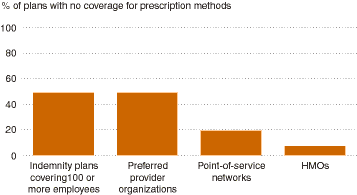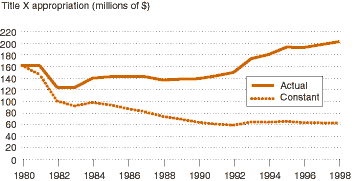Barriers to Contraception
Unintended pregnancy is a major problem in the United States that cuts across racial, ethnic, socioeconomic and demographic lines. By helping women to time and space their births, contraceptive use helps avoid the adverse health, social and economic consequences associated with unintended pregnancies.
In stark contrast to the situation in other developed nations, where contraceptives are easily affordable under universal health insurance systems, contraceptive supplies and services are expensive in this country, and American women must rely on a variety of fragmented systems and programs to help them cover these costs. In the absence of a more comprehensive system, any effective public policy effort to reduce levels of unintended pregnancy--and the abortions or unwanted births that inevitably result--must focus on strengthening the ability of these various systems and programs to meet the contraceptive needs of women and couples across the nation.
Background
Every year,
three million pregnancies in the United States, or half of all pregnancies
among American women, are unintended. These pregnancies often cause
significant hardship for women, their families and society at large. For
many women, an unintended pregnancy is a difficult, even life-altering,
experience--because it occurs when the woman is too young to be a parent
or is unmarried, too soon after her previous birth or after she has
achieved her desired family size.
Unintended pregnancies have ramifications for individual and public health. Women who experience such pregnancies are less likely to obtain timely prenatal care than those whose pregnancies are planned; as a result, their chances of adverse health outcomes increase. Health risks are also heightened when pregnancies follow shortly after another birth or occur among young adolescents or women past their childbearing prime.
Additionally, an unintended pregnancy may threaten a woman's ability to complete her education and participate in the workforce, jeopardizing her ability to support herself and her family. For this and other reasons, half of women experiencing an unintended pregnancy seek abortion--a reality that causes considerable anxiety and division among policymakers and within the general public.
However, using contraceptives is effective in reducing rates of unintended pregnancy. In any given year, 85 of 100 sexually active women not using a contraceptive become pregnant. By contrast, among women taking birth control pills (the most commonly used reversible method), only eight of 100 become pregnant. It is therefore not surprising that about half of all unintended pregnancies occur among the small proportion (7%) of women at risk of such pregnancies who do not use birth control.
One of the major barriers to universal contraceptive access in this country is that contraceptives can be expensive. For example, costs for supplies alone can run approximately $360 per year for oral contraceptives, $180 per year for the injectable, $450 for the implant and $240 for an IUD. In addition, the bulk of the cost for some of the most effective methods must be paid up front.
While most U.S. women rely on employer-based private insurance to pay for their health care, these plans historically have provided far less extensive coverage for contraceptives than for most other prescription drugs and devices. Public programs--Medicaid, the health insurance program for the poorest Americans; and Title X, the family planning safety-net program for low-income women without another source of payment--exist to help those who lack adequate private insurance. But many low-income Americans do not qualify for Medicaid, and Title X funding has not kept pace with program costs or inflation, hindering the program's ability to serve all those seeking care. Thus, many women, even those who are privately insured, face financial barriers to obtaining their chosen contraceptive methods.
Private
Insurance
Three-quarters of American women of childbearing
age rely on private insurance to defray their medical expenses. Yet many
private insurance plans provide inadequate coverage of contraceptive
services and supplies. This gap increases many women's risk of
experiencing an unintended pregnancy and helps explain why women of
reproductive age spend 68% more on out-of-pocket health care costs than do
men.
|
chart a Private Insurance Many plans cover no contraception at all. | |||
 | |||
| 49 | 49 | 19 | 7 |
| Note: Prescription methods are the oral
contraceptive, IUD, implant, injectable and diaphragm.
| |||
all types, and abortion in two-thirds.
Full contraceptive coverage in private insurance plans would be inexpensive and is popular among consumers.
Policy initiatives at the state and federal levels promise to improve contraceptive coverage through private health insurance by requiring plans to cover contraceptives to the same extent that they cover other prescription drugs.
prescription drug benefit.
Need for Public
Programs
Expanding access to family planning (contraceptives
and closely related services) has been a major aim of the U.S. government
since the mid-1960s. Federal support for family planning services derives
principally from two sources: Medicaid, the joint federal-state health
insurance program for poor Americans (created through Title XIX of the
Social Security Act); and Title X of the Public Health Service Act, the
only federal program devoted solely to the provision of family planning
services. These programs have a long history of success in providing
contraceptive services and reducing unintended pregnancy among low-income
women, teenagers and other women in need of subsidized services; they also
have made their mark by improving the health and financial well-being of
women and their children.
one-quarter.
In addition to providing these social and medical benefits, publicly funded family planning is cost-effective.
Medicaid
Under Medicaid,
the federal government and the states share the cost of providing medical
care to eligible low-income individuals. The program is the largest source
of public funds for contraceptive services in this country. In FY 1994,
Medicaid expenditures for contraceptive care totaled $332 million.
Given the importance of equalizing access to family planning services for low-income women, the Medicaid program provides special consideration for these services.
States set income eligibility requirements for the program within broad federal parameters, but many low-income women in need of contraceptive services fail to qualify. Recognizing the value of family planning services, states have petitioned the federal government for special permission to expand services to women with incomes above their general eligibility ceilings.
Title X
Title X is a
critical source of assistance for low-income women and teenagers, who
often are uninsured or have insurance under a plan that does not include
adequate coverage of contraceptives. The program was created in 1970 with
broad bipartisan support in response to research showing that rates of
unwanted childbearing among low-income women were at least twice those for
more affluent women.
Over the past three decades, the Title X clinic system has played a major role in helping women prevent unintended pregnancies, abortions and unplanned births. While Medicaid is the largest public funder of family planning services, Title X remains the heart of the national family planning system, largely determining both its structure--through the nationwide network of clinics--and the types and quality of services that are provided to subsidized and fee-paying clients alike.
Today, Title X-supported clinics face the challenge of maintaining high-quality care while they confront increasing costs of contraceptives and reproductive technologies, the need to serve growing numbers of uninsured women, and the imperative to expand service delivery to males and hard-to-reach populations such as substance abusers and the homeless.
|
chart b Title X Funding When inflation is taken into account, funding for Title X has decreased over the years. |
 |
| Notes: Calculation of constant dollars based on Consumer
Price Index for Medical Care. Years shown are fiscal years.
|
Conclusion
Given the
absence of universal contraceptive coverage in the United States, public
policies designed to reduce unintended pregnancy rates--which are high
compared with those of other developed countries--must concentrate on
strengthening each piece of the existing patchwork system. This includes
making sure that private insurance fully covers contraceptive supplies and
services, that states can easily extend Medicaid family planning services
to all poor women desiring contraceptives, and that Title X is adequately
funded to meet program costs and to serve growing numbers of people.
Expanding access to contraceptives will not by itself solve the problem of unintended pregnancy; much more can and should be done to achieve this goal. At a minimum, other necessary measures include investing in contraceptive research to improve and increase the range of available methods, and promoting responsible sexuality education that supports and encourages young people who want to delay sexual initiation, even as it prepares them to protect themselves against unplanned pregnancy when they do become sexually active. But clearly, increasing access to contraception must be at the heart of any national strategy to reduce unintended pregnancy.
Sources of Data
The Alan
Guttmacher Institute (AGI), Uneven and Unequal: Insurance Coverage and
Reproductive Health Services, New York: AGI, 1994.
Dailard C, Title X family planning clinics confront escalating costs, increasing needs, The Guttmacher Report on Public Policy, 1999, 2(2):1-2 & 14.
Darroch JE, Cost to Employer Health Plans of Covering Contra-ceptives, New York: AGI, 1998.
Families USA Foundation, Losing Health Insurance: The Unintended Consequences of Welfare Reform, Washington, DC: Families USA Foundation, 1999.
Forrest JD and Samara R, Impact of publicly funded contraceptive services on unintended pregnancies and implications for Medicaid expenditures, Family Planning Perspectives, 1996, 28(5):188-195.
Gold RB, State efforts to expand Medicaid-funded family planning show promise, The Guttmacher Report on Public Policy, 1999, 2(2):8-11.
Henshaw SK, Abortion incidence and services in the United States, 1995-1996, Family Planning Perspectives, 1998, 30(6):263-270 & 287.
Jamieson DJ and Buescher PA, The effect of family planning participation on prenatal care use and low birth weight, Family Planning Perspectives, 1992, 24(5):214-218.
Kaiser Family Foundation, National Survey on Insurance Coverage of Contraceptives, Menlo Park, CA: Kaiser Family Foundation, 1998.
Meier KJ and McFarlane DR, State family planning and abortion expenditures: the effect on public health, American Journal of Public Health, 1994, 84(9):1468-1472.
U.S. Bureau of the Census, Health insurance coverage: 1997, Current Population Reports, 1998, Series P-60, No. 202.
Women's Research and Education Institute (WREI), Women's Health Insurance Costs and Expenditures, Washington, DC: WREI, 1994.
Credits
This Issues in
Brief was written by Cynthia Dailard and was supported in part by The
Andrew W. Mellon Foundation.
